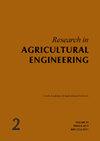Drying kinetics and mathematical modelling of Arundo donax L. canes, a potential renewable fuel
Q3 Agricultural and Biological Sciences
引用次数: 2
Abstract
Arundo donax L. is an energy crop with the potential use as a renewable fuel. This study focused on the drying process of the canes in field and laboratory conditions to determine the effect of the harvest conditioning on the kinetics parameters of whole and slashed canes. The lab drying test was conducted in a thin layer dryer at temperatures between 30 and 80 °C and a 0.5 m·s–1 air velocity. The whole and slashed canes showed faster water evaporation rates as the temperature increased, but the slashed canes achieved a lower final moisture content in a shorter time. The effective diffusion coefficient varied between 3.67 × 10–12 and 1.28 × 10–11 m2·s–1 and showed a significant effect of the temperature, but not between samples; its temperature dependence was determined by the Arrhenius equation giving activation energies of 24.4 and 20.2 kJ·mol–1 for the whole and slashed canes respectively, not significantly different. The modelling of the experimental drying data to six thin layer drying models achieved good performance (R2 > 95.9%), although the Logarithmic model showed the best fit for both samples (R2 > 99.4%). In addition, a temperature dependent equation for the drying constant was included in the Logarithmic model for the whole and slashed canes which predicted with good performance (R2 > 97%) the moisture loss. The developed tools constitute an adequate model for the simulation of the drying process of Arundo donax L. that could be useful for the design of various equipment and systems.一种潜在的可再生燃料——芦竹的干燥动力学及数学模型
阿伦多是一种有潜力作为可再生燃料的能源作物。本研究重点研究了甘蔗在田间和实验室条件下的干燥过程,以确定收获条件对整根和切下的甘蔗动力学参数的影响。实验室干燥试验在薄层干燥器中进行,温度在30至80°C之间,空气速度为0.5 m·s–1。随着温度的升高,整根和切开的甘蔗表现出更快的水分蒸发率,但切开的甘蔗在更短的时间内达到了更低的最终水分含量。有效扩散系数在3.67×10–12和1.28×10–11 m2·s–1之间变化,并显示出温度的显著影响,但样品之间没有;其温度依赖性由Arrhenius方程确定,整个和切开的甘蔗的活化能分别为24.4和20.2 kJ·mol–1,没有显著差异。实验干燥数据对六个薄层干燥模型的建模取得了良好的性能(R2>95.9%),尽管对数模型对两个样品的拟合最好(R2>99.4%)。此外,将干燥常数的温度相关方程纳入整条和切条甘蔗的对数模型中,该模型以良好的性能(R2>97%)预测了水分损失。所开发的工具构成了一个用于模拟Arundo donax L.干燥过程的适当模型,可用于各种设备和系统的设计。
本文章由计算机程序翻译,如有差异,请以英文原文为准。
求助全文
约1分钟内获得全文
求助全文
来源期刊

Research in Agricultural Engineering
Engineering, agriculture-
CiteScore
1.40
自引率
0.00%
发文量
21
审稿时长
24 weeks
期刊介绍:
Original scientific papers, short communications, information, and studies covering all areas of agricultural engineering, agricultural technology, processing of agricultural products, countryside buildings and related problems from ecology, energetics, economy, ergonomy and applied physics and chemistry. Papers are published in English.
 求助内容:
求助内容: 应助结果提醒方式:
应助结果提醒方式:


